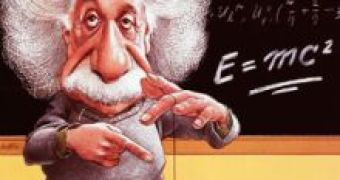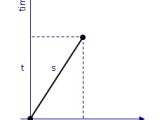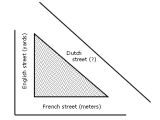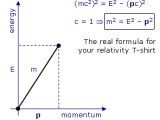The most famous formula in science describes the relation between energy and mass. But why is this relation as such and what does it have to do with the theory of relativity? The theory of relativity stems from the realization that when one observes something, there are always two different measures of time: on one hand, the time measured by the observer and on the other hand, the time as it is experienced by the observed thing. According to Newtonian mechanics, these two times should have always been the same, but experiments have shown that they actually never are. The "flow of time" is not absolute - it isn't experienced in the same way by everything. (See more details.)
Einstein's theory makes sense of this by describing everything in "space-time". This means that the frame of reference associated to each particular observer includes not only a coordinate system used to specify positions but also the observer's clock. As one switches from one observer to another there are certain quantities that remain the same - they are "invariant".
In Newtonian mechanics such invariant quantities include the length of things and, as mentioned, how long something lasts. In relativity neither the length nor the time period are invariant. What is invariant however is the length of any event in space-time. An "event" observed from a particular frame of reference with a particular clock is any description like "this particle has moved from this position to that position in so much time". (The image below is a little bit deceiving because the space-time is not Euclidean - meaning that the length of the event is not given by the typical Pythagoras theorem, but by a slightly modified version of that formula with a minus instead of a plus.)
But what does this have to do with E = mc^2? You might be surprised to know that this formula isn't really as fundamental as it is claimed. The complete formula refers not only to energy and mass but also to momentum. The E = mc^2 appears only in one very particular frame of reference where the momentum happens to be zero. Other observers also get the momentum.
In Newtonian mechanics momentum and energy are both conserved but they seem to be different kinds of physical properties. All this changes in the theory of relativity. The deepest and most general definitions of energy and momentum are as follows: The momentum is the thing that is conserved as a consequence of the fact that space is homogenous - i.e. that it doesn't matter where you chose to put the origin of your frame of reference. The energy is the thing that is conserved as a consequence of the fact that time is homogenous - i.e. that it doesn't matter what is the origin of your measurements of time (be it the Big Bang, the birth of Jesus Christ or Muhammad's trip from Mecca to Medina).
Thus, due to the fact that in relativity space and time get mixed together into space-time, energy becomes simply the time component of the four-dimensional momentum vector. The length of this vector is another invariant - all observers agree about it - and it has an interesting physical significance. It is the mass of the moving particle. Mass is the measure that describes how easy it is to change the velocity of the particle, to make it move faster or slower or to change its direction of motion. All observes agree about this.
What is that c constant?
Suppose you would measure the lengths in one direction using meters (on the French street) and yards to measure them in another direction (on the English street). What would then be the unit for length in some other oblique direction that is a combination of the two directions (the Dutch street)?
The consequence of such a crazy system would be that all the lengths on the Dutch street would have to carry around a constant that describes the relation between meters and yards. Such a constant would be a human artifact and not something saying anything about how long things are on the Dutch street. But if the English would finally adopt the metric system the Dutch constant would become 1 and all the lengths on the Dutch street would let go of that silly constant.
Due to historic reasons, this is exactly our situation in the theory of relativity in regard to space and time. We are used of measuring space in, say, meters and time in seconds. The constant that appears because of this inadequacy of measuring units is c, the speed of light. But if we choose the units properly, this constant becomes 1 and all the formulas in the theory of relativity become simpler. This is why in Einstein's formula there is mc^2 instead of just m - the units haven't been chosen properly. One clever way of measuring distances is to consider the time it takes light to cover them.
In its complete form, the Einstein's formula simply states that the mass is the length of the energy-momentum vector. But what does this formula mean?
As mentioned, both the energy and the momentum are conserved quantities. Mass however is not. For example during radioactive decay, a heavy element, such as uranium or plutonium, changes spontaneously into lighter elements. In case of the fusion reaction, that fuels the stars and occurs in H-bombs, hydrogen atoms are merged together into helium and the mass of the resulting atoms is smaller than the total mass of the initial atoms. When an electron and a positron (the anti-electron) meet they transform into light - which has no mass.
Forget about the mass - it can just disappear!
Unfortunately such reactions are often described by saying that the "mass turns into energy". Supposedly this is what Einstein's E = mc^2 is saying. But this is an unfortunate way of putting it because it suggests that the energy is not conserved. Supposedly it can change into something else. This way of talking is the consequence of our difficulty to understand that mass is not conserved. We feel the need to say what happens to mass, we need to keep track of it. But it isn't mass that we should track, but energy and momentum. They are the conserved quantities.
The mass cannot "turn into" energy, or conversely the energy cannot "turn into" mass as if mass and energy are different things. The total amount of energy after the reaction is exactly the same as before the reaction. The same also holds of each spatial component of the momentum.
The amount of energy or momentum can change only if there is an external force acting on the system - and this is not the case in such reactions because they occur in isolation.
Einstein's equation says that mass literally is energy and momentum - it is the length of that vector in four dimensions. In a frame of reference where the momentum is zero the mass is simply describing how much internal energy that particle has - but only in that frame of reference. In that case mass is just "potential energy".
When we take a pendulum out of equilibrium we say that it has a certain potential energy. By that we mean that if we let it go it will start to move - the potential energy will be transformed into kinetic energy. The same is true in case of mass - it is potential energy in the sense that if the nuclear forces don't hold the atom in its current form, the potential energy will turn into kinetic energy.
A particle having a certain mass has that amount of energy and momentum stored inside it irrespective of whether or not it will later change into a photon or some other particle. Because the mass itself is not conserved, a particle with mass can change into something with a different mass (or even with no mass at all), but the energy and the momentum of the original mass are identical to the energy and momentum of the resulting particles.
For example, the energy and the momentum of light are connected to its frequency and wave-length. The photons which appear when an electron hits a positron, and "annihilate" each other, will have such a wave-length that the photons' energy and momentum will be the same as that of the now gone electron and positron. Because the mass of the electron and positron represents a lot of energy, the resulting photons will be gamma-rays (high-energy photons).
Similarly, during radioactivity or during fusion, the difference in mass has to appear in other forms of energy and momentum. This is why these reactions also emit light and can take the form of explosions. An explosion simply means that the newly created particles have a lot of momentum - the potential momentum previously stored inside the mass is now released.
Forces
What happens when external forces are present? The energy-momentum vector changes in a certain way but how? It is interesting that the electromagnetic force just rotates this vector. The length of the vector - i.e. the mass - is not affected. The nuclear forces on the other hand, the forces responsible for what happens during radioactivity and fusion, do modify the mass. In fact, these forces are the very reason why mass is not conserved. The idea that mass can disappear or appear out of nowhere seems so unintuitive to us precisely because we are not used to experiencing radioactive events in our everyday lives.
How about gravitation? Gravitation, of course, fits very well within the Newtonian framework. As long as we keep space and time, momentum and energy, separated, we can deal with gravitation easily. But when we combine them into a single mathematical entity problems arise because it's hard to tell how gravitation changes the momentum-energy vector. The solution to this problem was given by Einstein ten years after the formulation of the E = mc^2 law.
Instead of figuring out how gravitation changes the momentum-energy vector he figured out that he can describe gravitation as changing the shape of the space-time. In other words, gravitation leaves the momentum-energy vector unchanged - it is as if there is no force whatsoever - the particle continues to move in a straight line with the same speed as before. But the space in which it is moving is changed. There are many images of this idea, usually picturing a sort of deformation in space. However, these pictures are misleading because gravitation, as it is described by Einstein's theory, is a deformation at the interface between space and time and not between two coordinates of space. This of course is harder to picture!
The electromagnetic force and the nuclear forces can be unified into a single force that acts upon the energy-momentum vector. This force has been described in quantum mechanical terms. But unifying this force with gravitation has proven to be much harder than expected. Because gravitation changes the space-time while the other forces change the energy-momentum, such a unification of all forces would also imply a unification of space-time with energy-momentum. It's hard to tell what this could mean.

 14 DAY TRIAL //
14 DAY TRIAL // 



